August 20, 2017
When people ask me, “What’s your favorite place,” I usually respond, “Where I am.”
While that’s unusually diplomatic for me, it may well be true about where I am now; Siena would definitely earn a place in my top ten. It certainly has many attractions that have kept me busy the last two days, to my surprise and pleasure.
Our introduction to Tuscany (the part of Italy we’re in) was a series of fortified towns we whisked by, atop hills, an indication of the warlike period that dominated Italy after the fall of the Roman empire.
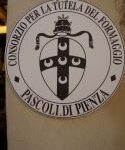
 We stopped at Pienza, one of them, which gave us a taste of what we’d see in Siena—a walled city, dominated by a church and town hall that reflected the wealth of the Piccolomini family. The family crest intrigued me, since it included 5 crescent moons, which our guide explained represented the five crusades that the family sponsored. We were soon to learn that the family contributed at least two popes, and were partly responsible for creating, in Siena, one of the best medieval cities, still preserved as such today. It “helped” that the plague in 1348 killed 2/3 of the population and reduced the ability of the survivors to update the city’s architecture.
We stopped at Pienza, one of them, which gave us a taste of what we’d see in Siena—a walled city, dominated by a church and town hall that reflected the wealth of the Piccolomini family. The family crest intrigued me, since it included 5 crescent moons, which our guide explained represented the five crusades that the family sponsored. We were soon to learn that the family contributed at least two popes, and were partly responsible for creating, in Siena, one of the best medieval cities, still preserved as such today. It “helped” that the plague in 1348 killed 2/3 of the population and reduced the ability of the survivors to update the city’s architecture.
 In the middle ages, say 1100-1500, Siena vied with Florence for domination of central Italy, a rivalry that continues today. In 1555, the Florentines defeated the Sienese, destroyed the Sienese fort, and replaced it with a Florentine fort that exists today. You know I love forts, and the Fortezza is a block from here. Our guide said I was the first person on his trips to actually seek it out, and I took Carolyn there for dinner in what had once been the dungeon and arsenal. The Florentine conquest inaugurated Medici rule. The new
In the middle ages, say 1100-1500, Siena vied with Florence for domination of central Italy, a rivalry that continues today. In 1555, the Florentines defeated the Sienese, destroyed the Sienese fort, and replaced it with a Florentine fort that exists today. You know I love forts, and the Fortezza is a block from here. Our guide said I was the first person on his trips to actually seek it out, and I took Carolyn there for dinner in what had once been the dungeon and arsenal. The Florentine conquest inaugurated Medici rule. The new rulers ordered the leveling of towers on the palazzos. Towers had been necessary because the rivalries were not just between the cities, but frequently between families as well (see West Side story).
rulers ordered the leveling of towers on the palazzos. Towers had been necessary because the rivalries were not just between the cities, but frequently between families as well (see West Side story).
Sienese still celebrate a 1260 or so victory, and any football victories, with gusto. The city, which was larger in the middle ages than it is today, had three major centers.
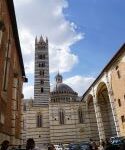
 The first was the religious. Atop one of the hills sits the Duomo, a 13th century masterpiece in white and alternating black (they say it’s dark green) that is visible miles away, with a massive presence and glistening with medieval art. It’s part Romanesque and part Gothic. One of the most stunning chapels is the Piccolomini library, built to house the collection of manuscript-books of that famous Pienza family. I visited the church museum (where many of the real sculptures are kept; so is the rose window. Copies are in the church), the baptistry, and the crypt. The last
The first was the religious. Atop one of the hills sits the Duomo, a 13th century masterpiece in white and alternating black (they say it’s dark green) that is visible miles away, with a massive presence and glistening with medieval art. It’s part Romanesque and part Gothic. One of the most stunning chapels is the Piccolomini library, built to house the collection of manuscript-books of that famous Pienza family. I visited the church museum (where many of the real sculptures are kept; so is the rose window. Copies are in the church), the baptistry, and the crypt. The last 
 named was rediscovered in 1999; it had been filled with debris on which the church rested. Opening it required using steel to support the church.
named was rediscovered in 1999; it had been filled with debris on which the church rested. Opening it required using steel to support the church.
Across from the church is what had been a hospital since the 12th century. Our local guide said it was a hospital until 1996, and she’d been born in it. It’s now a museum, with some relics that date back to 1359, when they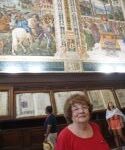 “came from the East.” I’d read that the Byzantines literally sold off the family jewels to repay debts, and these relics were purchased, and included what purports to be a nail from the True Cross and a vial with blood from Jesus. That the Sienese could purchase these items reflects the wealth of the town.
“came from the East.” I’d read that the Byzantines literally sold off the family jewels to repay debts, and these relics were purchased, and included what purports to be a nail from the True Cross and a vial with blood from Jesus. That the Sienese could purchase these items reflects the wealth of the town.
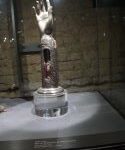 There are lots of other churches here, too. We visited one last night that houses the head of St. Catherine of Siena (15th century). Our guide said that before the Council of Trent, relics from martyrs were sold as money-makers for the church (the Duomo has an arm of St. John the Baptist, given by one of the Palaeologus, the Byzantine royal family, to the city).
There are lots of other churches here, too. We visited one last night that houses the head of St. Catherine of Siena (15th century). Our guide said that before the Council of Trent, relics from martyrs were sold as money-makers for the church (the Duomo has an arm of St. John the Baptist, given by one of the Palaeologus, the Byzantine royal family, to the city).
The second center of the city is civil. The city was a republic in its glory years, with Nove (9) elected counselors who held forth in a city hall. I 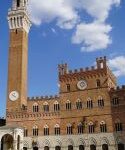 toured the museum there, which had some frescos
toured the museum there, which had some frescos celebrating the results of good government (people dancing), and lamenting the results of bad government (watch the news today). There were 9 districts—today there are 42, and we visited one of the “community centers.” Their rivalry culminates in two horse races a year, one in July, and one August 15, which we just missed, run in the “Campo,” a field in front of the city hall. The districts draw horses by lot and jockeys by lot, and bless the horses in the district and in the fountain in front of the city hall. It sounds like the world series, but there’s obviously a lot of chance in it. The Romanesque tower, 500 steps high (I resisted the temptation to climb it), next to the hall, is iconic.
celebrating the results of good government (people dancing), and lamenting the results of bad government (watch the news today). There were 9 districts—today there are 42, and we visited one of the “community centers.” Their rivalry culminates in two horse races a year, one in July, and one August 15, which we just missed, run in the “Campo,” a field in front of the city hall. The districts draw horses by lot and jockeys by lot, and bless the horses in the district and in the fountain in front of the city hall. It sounds like the world series, but there’s obviously a lot of chance in it. The Romanesque tower, 500 steps high (I resisted the temptation to climb it), next to the hall, is iconic.
The third center is economic, and that was the key to Siena’s success. Siena was on one of the major pilgrimage routes, from Canterbury to Rome. Hence, the hospital, which started as a bed and breakfast, hence the churches, and hence the development of services for the pilgrims. Essentially, that meant the evolution of banks. People would set out boards (banko or something like that in Italian), and offer to change money, the ATMs of the day. Thus emerged the bank of Siena in 1472, still in existence today, although a recent 8 million euro bailout has damaged its credibility. And, when a banker died, his “board” was broken and left in front of his former place of business (hence, in Italian, bankrupt!)
In other words, Siena’s wealth came from tourism, and, from what I’ve seen on the streets in the old city, that may still be true today! Some things never change.